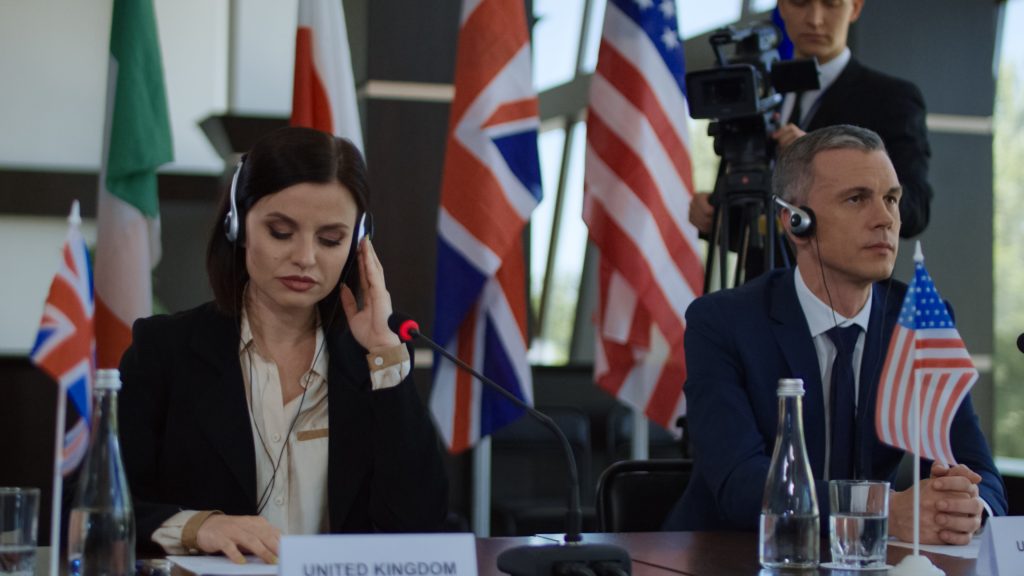Linguists, Business Owners
Introduction
When I was at university studying language translation and interpretation, people often asked me this question: “What’s the difference between translation and interpretation?” These two concepts still prove confusing today so that people either ask themselves the same question or use these terms interchangeably.
Some other people wonder who operates the devices used during some high-end symposia settings. While some people believe that the tools are set to operate automatically on their own, that’s not the case at all. The simple answer is that the interpreters do speak through the radio receivers. So, the speaker’s message is not automatically interpreted by these technological tools. The radio receivers are assigned channels through which interpreters speak to a specific audience in their language on behalf of the speaker. Basically, each audience listens to the interpretation through a designated channel.
In our North American region, for example, people simply use “translation” to refer to both translation and interpretation. I worked with one organization for several years as an interpreter, but I was known as a translator the whole time. In this article, I will discuss the difference between these two concepts to shed light on the confusion around them. In this first part, I will focus on interpretation. Therefore, whatever is not included in this article has nothing to do with interpretation.
Types of Interpretation
In the language industry, the different types of interpretation are called “modes” (~ of interpretation). There are various modes of interpretation based on the setting, purpose, number of listeners, technicalities, technology involved, and timescales. Consider the following mode based on the setting:
Chuchotage:

Chuchotage consists in the interpreter translating verbally for one (or a small number of) attendee(s). It can be used both in casual meetings and formal events. The interpreter usually sits beside the target audience and speaks into their ear(s), hence the name “chuchotage” (French for “whispering”). This is because the interpreter whispers into the listener’s ear. The interpreter talks at the same time as the main speaker of the source language even though the level of faithfulness to the speaker’s pace varies from one interpreter to another.
Chuchotage works well in environments where there are only a few people who don’t speak the source language. The setting makes it unnecessary for the interpreter to stand alongside the main speaker and hold a second microphone or sit in a booth to render the session in the target language. For example, if there is only one person who doesn’t speak the language in a big group of attendees at a conference, sometimes it is more convenient to sit with an interpreter and listen directly to them in one’s language. If there are several people who need this type of interpretation, they must group themselves around the interpreter to hear them clearly. The recommended number of listeners range between one and four.
This mode of interpretation has its own limitations and challenges. In the case of meetings, for example, there are limited options to reduce background noise or control people who may be talking around the target audience at the same time as the speaker and the interpreter. To cope with noise and distractions, the listener(s) must concentrate while the interpreter must maintain a comfortable pitch to make sure that their audience is seamlessly capturing the message. Chuchotage can be classified under the simultaneous or semi-consecutive interpreting modes that I will discuss below.
Based on the technicalities, specialty, and technology involved, we can differentiate between:
Sign Language Interpretation:

This is another category of visual interpretation where the interpreter uses signs to speak to a specific group of people. It is used in the media, for example, where a sign language professional renders the content of the broadcast news using visual signs. This mode of interpretation is intended for people who are hearing-impaired. It has different variants, one of which is the “American Sign Language” (ASL) used mostly in North America.
Sign language requires intensive training, just like any other professional field. It has its own alphabet, terminology (signs) and specializations. Therefore, a sign language professional who specializes in the medical field is not necessarily able to interpret in a legal setting. Sign language interpretation is one of the fastest-growing industries centered on the values of equity, integration, and social inclusion across the global communities.
Simultaneous Interpretation:

As its name goes, simultaneous interpretation consists in the speaker and interpreter speaking at the same time. It is used mainly in multilevel conferences where many of the attendees don’t speak the source language. This interpretation process uses modern technology to render the speaker’s message to as many people as possible, in real time.
As opposed to chuchotage and sign language, simultaneous interpreters usually don’t appear in front of the audience. However, there are some situations where they can do so, for example if the target language comprises only two different people groups—those who understand the language and those who don’t. If there are several people groups, interpreters sit in booths where assistive technological tools are set up to make the process smooth. In that case, people can see the speaker who is delivering the message in the source language but cannot see the interpreters who are delivering the message in the target language.
The most commonly known tools used in simultaneous interpretation are microphones and headsets used by the interpreters, speakers used by the main speaker, and radio receivers and headsets used by the listeners. The fact that the interpreters use booths as designated areas of service makes the interpretation highly efficient with little to no distraction and background noise.
Due to the intensity of this mode of interpretation, language experts recommend having backup linguists so that they can take turns. In most cases, there can’t be just one interpreter. The number of linguists vary based on the length of session(s), but the recommended number is at least two interpreters. Ideally, one interpreter speaks only for half an hour and takes a break for the next one to take over. This is why the process necessitates more than one interpreter. The risk associated with interpreting long sessions nonstop is quite high. The repercussions range from hoarseness to migraine headaches and various mental as well as physical health issues.
Semi-Consecutive Interpretation:
In the language industry, it is believed that the interpreter cannot start talking at the same time as the main speaker or keep up with them. This is especially because no one knows what’s on the other person’s mind. For this reason, language professionals believe that simultaneous interpretation should have a subcategory that recognizes a delay in the delivery of the main speaker’s message. Once the speaker and the interpreter are not speaking at the same time, the process can no longer be called “simultaneous”. That’s why the term “semi-consecutive” interpretation fits between real-time (simultaneous) and deferred (semi-consecutive) interpretation processes.
The reasons for the delay vary. The first and most understandable reason is that the interpreter must figure out the speaker’s message to begin with. Even though, most of the times, the speaker shares the content of their speech with the interpreter ahead of time, it doesn’t totally remove the unpredictability of the speaker’s introductory message such as greeting, illustration, or any other situation-based sense of humor that the speaker can spontaneously add into their speech to complete their story.
Consecutive Interpretation:

Consecutive interpretation is one of the most common modes of verbal communication between people who don’t share the same language. The scenarios vary. In casual situations, the interpreter can simply render the speaker’s message one sentence at a time. However, in formal situations, the interpreter is obliged to take structured notes summarizing the speaker’s message so that they can verbally render it afterwards. The speaker pauses for the interpreter to speak, usually after timeframes that can range between one and five minutes.
What makes the consecutive interpretation process complex is that the interpreter must use their cognitive skills to listen in the source language, process the information mentally, and speak in the target language. Sometimes they have to retrieve appropriate terminology as they listen at the same time. They must avoid distractions to stay focused on the speaker’s message.
Without notetaking, the interpreter can easily lose track of the message. The European Commission says that “in order to be a good consecutive interpreter, you must be able to listen very actively, analyze what the speaker is saying, make useful notes which will jog your memory of the speech as you give it back, and then be able to make the speech as if it were your own in your active language.”
The purpose of notetaking is to make the process as smooth as possible. While there is no rule about what elements of the speaker’s message must be noted down, there are some recommendations. The rule of thumb is for the interpreter to make sure that the most important parts of speech are documented for convenience during the reproduction stage. They can feel free to use abbreviations, language codes, or their own preferred symbols provided that they are able to decipher them as they interpret.
Some of the most popular sections to note down are names (of places and people); dates; numbers; measurements; amounts; units; lists, and probably some important titles, whether books, articles, or other similar content. Once these crucial details are documented, it becomes easier for the interpreter to reproduce the speaker’s message and bounce back and forth from the notes instead of trying to retrieve all the contents from their memory. It is also important to note that notes can easily sidetrack the interpreter from the job at hand. So, they must keep their mind sharp and ready to rock and roll at all times.
In the interpretation world, there are two types of memories―long and short-term. Some interpreters have very good memories and can retain long chunks of the message. These are said to have long-term memories (LTMs). Another category of interpreters can only retain small bits of the message for a short time. These are known as having short-term memories (STMs). Either way, the art of notetaking is absolutely crucial and commonly used in the consecutive interpreting process, even though some confident LTM interpreters can go without it.
>> Stay tuned for Part Two about “translation”!
Message to My Readers:
I hope you found my article helpful. I would love your feedback below. My goal is to add value to my readers and, particularly, to my clients by making their businesses more profitable and hassle-free. If you would like to learn more about how our language services can support your specific business model, I would be pleased to connect and discuss your questions further.
Introduction
In August, I discussed the interpretation modes, process, and scope. Click here to read part one regarding the interpretation process. In this September article, I will focus on translation. Translation is a reproduction of written content in written form from the source (language of origin) into the target language (language of destination). Translation cannot be performed in real time or verbally.
The translation process is carried out by a translator using required the tools, which range from a computer, reference resources, and software. It bounces between two main factors, which are language and culture. There must complete congruence between these two concepts for the translation to be acceptable.
In the translation industry, the evolution of technology has allowed for the invention of technological tools that translators can utilize to speed the timescales, but they are handled by humans. Computers can also perform automatic translations, also known as “machine translation”.
Machine translation cannot be relied on in terms of quality since the computer doesn’t speak any language. If used, automatic translation needs to be handled by an experienced translator professional who will perform additional steps. Language professionals and clients who focus on quality do not prefer this option.
One of the most popular steps performed on top of machine translation is post-editing, also sometimes called machine translation post-editing (MTPE). To achieve the desired results, MTPE can be performed multiple times as needed until the final translation is accurate and error-free. Click here to read more about our MTPE process.
For more information about the translation process, please refer to my May article about 8 fundamental steps to successfully carry our translations (and localizations) up to the final version in ascending order.
For translation to be efficient, the translator does not simply reproduce words from the source to the target language. There are quite a few translation techniques that vary based on the language content, intended audience, and the intended use of the translation.
This may sound confusing since translation is a reproduction of a given text in written form, but the reason being is that translation must flow naturally and read like the original text. Otherwise, it would not make sense to a native speaker of the target language.
For example, word for word translation sounds quite diluted and awkward. In the language industry, it is known as “literal”, or simply “word for word” translation. A good example of this would be machine translation. A computer translates individual words without considering lexical, syntactic, and semantic nuances.
Consider the following translation techniques:

Adaptation:
Adaptation as a translation technique is resorted to if there is no lexical equivalence in the target language. It is a widely used technique, especially while translating into rare language whose terminology is limited.
This may require adapting foreign texts to accommodate new concepts in the target language. Even though it is critiqued for its limitedness in terms of how much meaning it really carries, adaptation is widely accepted as a way of rendering the language that would otherwise have no equivalence whatsoever.
In contrasting translation and adaptation, some language professionals define adaptation as a set of translative operations that result in a text that is not generally accepted as a translation but is nevertheless traced to a source text”.
According to this definition, adaptation is a text resulting from translative operation, but cannot be called a translation because of its overall distortion, falsification of the source text and deviation from literality in such a way that the resulting text is so globally distant from the source text. Click here to read more about the concept of adaptation.
Based on the nature of its rationale, professional translators differentiate between local adaptation and global adaptation. Local adaptation applies to concepts that are limited to the local culture and geographical location, while the global adaptation technique refers to concepts that are intended for the global audience.
Modulation:
As mentioned above, the translation process is not about merely changing words in a different language. The modulation technique, therefore, is used to convey the same meaning in the target language by introducing a semantic change. The translator uses this technique to avoid word for word translation. This makes the final product sound original to the target people in their original language.
Modulation cares more about the cultural meaning as opposed to lexical meaning. Using this technique helps to come up with coherent and culturally acceptable concepts in the target language. Cambridge Dictionary defines modulation as “a change in the style […]”, or “a small change that happens in response to something or is intended to achieve an effect”.
Literal translation:
In some cases, literal translation is acceptable if the source and the target languages are semantically and structurally close. As long as the translation will retain the style and produce the desired meaning, the translator can translate word for word. This, of course, depends on whether the two languages are bound by a syntactic and semantic relationship.
Even though the word for word translation technique (also called calque) is sometimes used synonymously with literal translation, it is a different technique that focuses on choosing words or expressions on purpose to translate the source language by keeping the original style.
Equivalence:
Equivalence is used to convey concepts that don’t have equivalents in the target language. In this case, the translator employs this technique to render the same meaning as the original using a different expression. Equivalence is commonly used to translate popular adages and literary writings which wouldn’t otherwise be accurately translatable.
The process of equivalence changes the entire meaning and crates a completely different idea in the target language. Somebody who doesn’t understand the original language wouldn’t necessarily know anything else than what they are told by the translator.
Equivalence in meaning is critiqued by some language experts because it alters the original meaning. Umberto Eco says that “equivalence in meaning cannot be taken as a satisfactory criterion for a correct translation”. This is because equivalence relies on synonymy, whereas it is commonly accepted that there are no complete synonyms in language (see Experiences in Translation, 2001, page 9).
Transposition:
This technique alters the grammatical structure of a phrase or sentence without changing its meaning. In this style, the words in the source language would have different positions in the target language. The equivalent concepts are moved at the beginning, in the middle, or the end of a sentence to make the translation as idiomatic as possible.
The transposition technique is known for its idiomacy. In other words, translators who utilize transposition are highly knowledgeable and produce idiomatic translations. This technique is commonly used in world languages such as English, French, and others that have enough terminology and therefore can have semantic similarities but employ different grammatical categories.
Borrowing:
Lexical borrowing is taking words or expressions from one language and using them in a different language without translating them. The purpose of borrowing can vary. However, the most common reason for borrowing is the lack of lexical equivalence in the target language, which necessitates borrowing terminology.
There are many foreign concepts in the English language that were borrowed from other languages. For example, cliché, post scriptum (p.s.), curriculum vitae (CV), and et cetera (etc.). To remain faithful to the source language (since there are no complete synonyms in language), professional translators prefer using this technique to avoid losing the original meaning of the words or expressions. Sometimes the borrowing technique is used to create a stylistic effect.
Message to My Readers:
I hope you found my article helpful. I would love your feedback below. My goal is to add value to my readers and, particularly, to my clients by making their business operations more profitable and hassle-free. If you would like to learn more about how our language services can support your specific business model, I would be pleased to connect and discuss your questions further.
Over the years, Sim acquired vast experience while working with some of the world’s leading brands. He is passionate about sharing his extensive expertise and business acumen to help scaling businesses to build their niche, expand their markets, and internationalize their brands.
- How to Approach Financial Expectations with Your New Language Service Clients - March 20, 2024
- The Impact of AI on the Linguistic Career - November 10, 2023
- Every Language Translation Process Hinges on these 7 Linguistic Meanings - October 14, 2023


